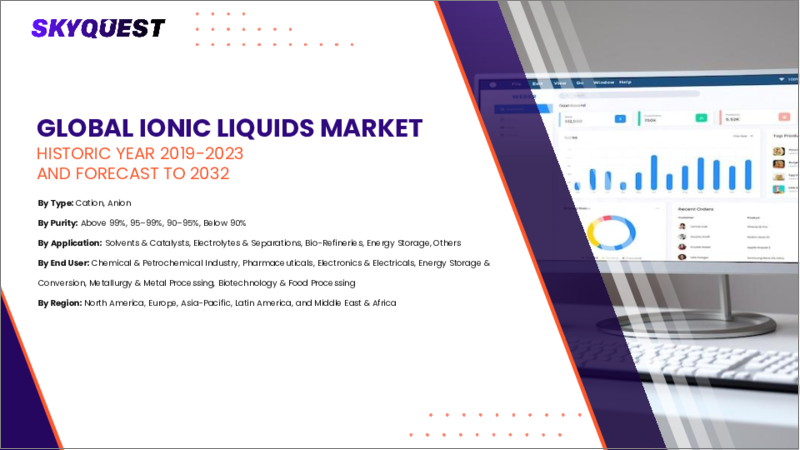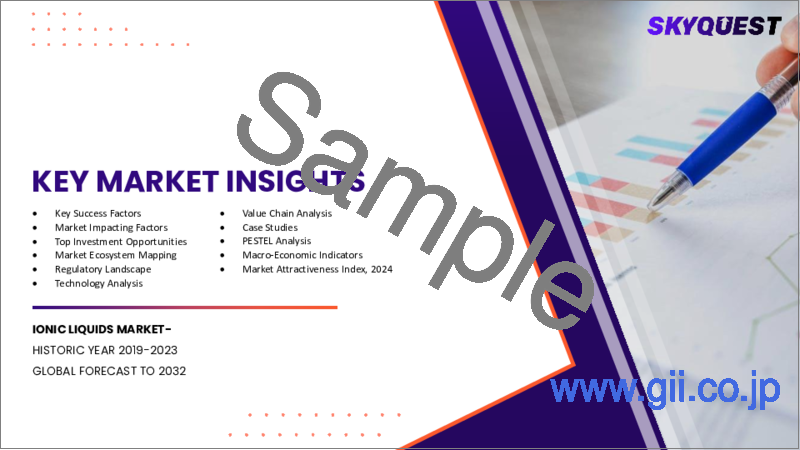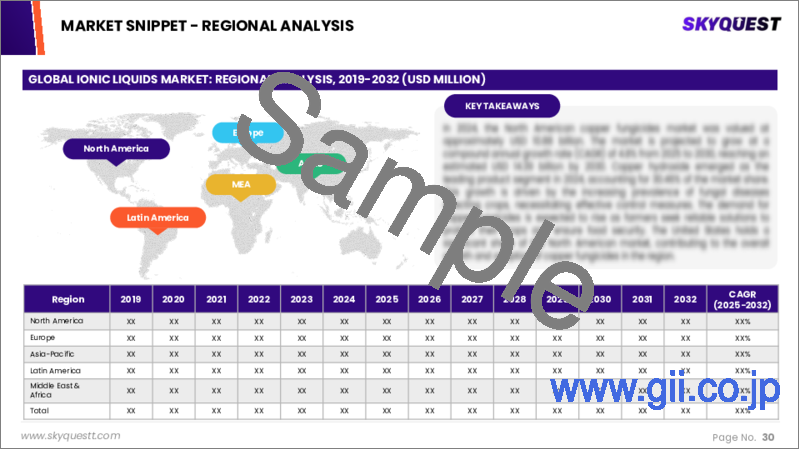|
|
市場調査レポート
商品コード
1619068
イオン液体の市場規模、シェア、成長分析、製品タイプ別、用途別、最終用途産業別、地域別 - 産業別予測、2024~2031年Ionic Liquids Market Size, Share, Growth Analysis, By Product Type (Ammonium-Based Ionic Liquids, Imidazolium-Based Ionic Liquids), By Application (Process Chemicals, Performance Chemicals), By End-Use Industry, By Region - Industry Forecast 2024-2031 |
||||||
|
|||||||
| イオン液体の市場規模、シェア、成長分析、製品タイプ別、用途別、最終用途産業別、地域別 - 産業別予測、2024~2031年 |
|
出版日: 2024年12月20日
発行: SkyQuest
ページ情報: 英文 157 Pages
納期: 3~5営業日
|
全表示
- 概要
- 目次
イオン液体の世界市場規模は、2022年に21億米ドルと評価され、2023年の22億8,000万米ドルから2031年には43億8,000万米ドルに成長し、予測期間中(2024-2031年)のCAGRは8.5%で成長する見通しです。
イオン液体の世界市場は、低揮発性や卓越した溶媒和能力など、化学、エネルギー、医薬品など多様な分野に応用可能な特徴的な特性によって大きな成長を遂げています。主な用途には、触媒作用、電気化学、環境に優しい溶媒の開発などがあり、持続可能で効率的な技術に対する需要の高まりと一致しています。この市場拡大は、生産プロセスの最適化、新しい用途の発見、環境への影響の緩和を目指した継続的な調査と革新的な取り組みによってさらに推進されています。その結果、イオン液体市場は継続的な進化を遂げる態勢を整え、グリーンテクノロジーの推進と産業界のニーズへの対応におけるその重要性を際立たせています。
目次
イントロダクション
- 調査の目的
- 調査範囲
- 定義
調査手法
- 情報調達
- 二次データと一次データの方法
- 市場規模予測
- 市場の前提条件と制限
エグゼクティブサマリー
- 世界市場の見通し
- 供給と需要の動向分析
- セグメント別機会分析
市場力学と見通し
- 市場概要
- 市場規模
- 市場力学
- 促進要因と機会
- 抑制要因と課題
- ポーターの分析
主な市場の考察
- 重要成功要因
- 競合の程度
- 主な投資機会
- 市場エコシステム
- 市場の魅力指数(2023年)
- PESTEL分析
- マクロ経済指標
- バリューチェーン分析
- 価格分析
- 規制情勢
- ケーススタディ
イオン液体市場規模:製品タイプ別およびCAGR(2024~2031年)
- 市場概要
- アンモニウム系イオン液体
- イミダゾリウム系イオン液体
- フォスフォニウム系イオン液体
- ピロリジニウム系イオン液体
- ピリジニウム系イオン液体
- その他
イオン液体市場規模:用途別およびCAGR(2024~2031年)
- 市場概要
- プロセス化学品
- パフォーマンス化学品
- その他
- 溶剤と触媒
- プラスチック
- 電気化学と電池
- バイオ精製所
- エレクトロニクス
- 紙・パルプ
イオン液体市場規模:最終用途産業別およびCAGR(2024~2031年)
- 市場概要
- 化学処理
- エネルギー貯蔵
- 医薬品
- 飲食品
- その他
- 環境
- バイオテクノロジー
イオン液体市場規模およびCAGR(2024~2031年)
- 北米
- 米国
- カナダ
- 欧州
- ドイツ
- スペイン
- フランス
- 英国
- イタリア
- その他欧州地域
- アジア太平洋地域
- 中国
- インド
- 日本
- 韓国
- その他アジア太平洋地域
- ラテンアメリカ
- ブラジル
- その他ラテンアメリカ地域
- 中東・アフリカ
- GCC諸国
- 南アフリカ
- その他中東・アフリカ
競合情報
- 上位5社の比較
- 主要企業の市場ポジショニング(2023年)
- 主な市場企業が採用した戦略
- 市場の最近の動向
- 企業の市場シェア分析(2023年)
- 主要企業の企業プロファイル
- 会社概要
- 製品ポートフォリオ分析
- セグメント別シェア分析
- 収益の前年比比較(2021~2023年)
主要企業プロファイル
- BASF SE(Germany)
- Solvay S.A.(Belgium)
- Merck KGaA(Germany)
- Ionic Liquids Technologies GmbH(Germany)
- Proionic GmbH(Austria)
- Strem Chemicals, Inc.(USA)
- Tatva Chintan Pharma Chem Pvt. Ltd.(India)
- Reinste Nanoventure(India)
- Solvionic(France)
- Scionix Ltd.(UK)
- Evonik Industries AG(Germany)
- Sigma-Aldrich Corporation(USA)
- Tokyo Chemical Industry Co., Ltd.(Japan)
- Thermo Fisher Scientific Inc.(USA)
- Iolitec Ionic Liquids Technologies GmbH(Germany)
- Greenyug LLC(USA)
- Jiangxi Huayi New Material Co., Ltd.(China)
- Tatva Chintan Pharma Chem Ltd.(India)
- Solvionic SA(France)
- Koei Chemical Co., Ltd.(Japan)
結論と推奨事項
Global Ionic Liquids Market size was valued at USD 2.1 billion in 2022 and is poised to grow from USD 2.28 billion in 2023 to USD 4.38 billion by 2031, growing at a CAGR of 8.5% during the forecast period (2024-2031).
The global ionic liquids market is witnessing significant growth, fueled by their distinctive properties, including low volatility and exceptional solvation capabilities, which make them applicable across diverse sectors such as chemistry, energy, and pharmaceuticals. Key applications encompass catalysis, electrochemistry, and the development of environmentally friendly solvents, aligning with the rising demand for sustainable and efficient technologies. This market expansion is further propelled by ongoing research and innovative efforts aimed at optimizing production processes, discovering new applications, and mitigating environmental impacts. As a result, the ionic liquids market is poised for continued evolution, highlighting its importance in advancing green technologies and meeting industry needs.
Top-down and bottom-up approaches were used to estimate and validate the size of the Global Ionic Liquids market and to estimate the size of various other dependent submarkets. The research methodology used to estimate the market size includes the following details: The key players in the market were identified through secondary research, and their market shares in the respective regions were determined through primary and secondary research. This entire procedure includes the study of the annual and financial reports of the top market players and extensive interviews for key insights from industry leaders such as CEOs, VPs, directors, and marketing executives. All percentage shares split, and breakdowns were determined using secondary sources and verified through Primary sources. All possible parameters that affect the markets covered in this research study have been accounted for, viewed in extensive detail, verified through primary research, and analyzed to get the final quantitative and qualitative data.
Global Ionic Liquids Market Segmental Analysis
Global Ionic Liquids Market is segmented by product type, application, end-use industry and region. Based on product type, the market is segmented into ammonium-based ionic liquids, imidazolium-based ionic liquids, phosphonium-based ionic liquids, pyrrolidinium-based ionic liquids, pyridinium-based ionic liquids and others. Based on application, the market is segmented into process chemicals, performance chemicals and others. Based on end-use industry, the market is segmented into chemical processing, energy storage, pharmaceuticals, food & beverage and others. Based on region, the market is segmented into North America, Europe, Asia Pacific, Latin America and Middle East & Africa.
Driver of the Global Ionic Liquids Market
The global ionic liquids market is being significantly driven by the rising demand for eco-friendly and sustainable processes across several industries, including energy, chemicals, and electronics. As organizations increasingly prioritize sustainability, ionic liquids' unique characteristics-such as low volatility and high thermal stability-make them an appealing choice for a wide range of applications. This shift toward greener alternatives not only enhances operational efficiency but also fosters compliance with environmental regulations, ultimately boosting the adoption of ionic liquids. Consequently, the market demonstrates a positive outlook as industries seek to integrate more sustainable practices into their operations.
Restraints in the Global Ionic Liquids Market
The global ionic liquids market faces several restraints that impede its growth. One significant factor is the high production costs associated with ionic liquids, which limit their affordability and accessibility for broader applications. Additionally, there is a lack of comprehensive understanding regarding the potential environmental and health risks linked to specific ionic liquids, creating hesitancy among potential users. Regulatory hurdles further complicate market entry and expansion, while competition from alternative solvents adds an extra layer of challenge. Collectively, these factors contribute to the caution surrounding the widespread adoption of ionic liquids in various industries.
Market Trends of the Global Ionic Liquids Market
The global ionic liquids market is currently experiencing a robust upward trend, largely fueled by their increasing applicability across various sectors including pharmaceuticals, renewable energy, and advanced chemical synthesis. The unique attributes of ionic liquids, such as low volatility and adjustable solubility, are driving innovation and research into more sustainable production methods. Collaborative efforts between academic institutions, industrial players, and governmental organizations are enhancing the understanding and utilization of these substances, promoting novel applications. As environmental regulations become more stringent and the demand for eco-friendly solutions rises, the market is anticipated to grow steadily, supported by advancements in synthesis methodologies and an expanding commitment to green chemistry initiatives.
Table of Contents
Introduction
- Objectives of the Study
- Scope of the Report
- Definitions
Research Methodology
- Information Procurement
- Secondary & Primary Data Methods
- Market Size Estimation
- Market Assumptions & Limitations
Executive Summary
- Global Market Outlook
- Supply & Demand Trend Analysis
- Segmental Opportunity Analysis
Market Dynamics & Outlook
- Market Overview
- Market Size
- Market Dynamics
- Drivers & Opportunities
- Restraints & Challenges
- Porters Analysis
- Competitive rivalry
- Threat of substitute
- Bargaining power of buyers
- Threat of new entrants
- Bargaining power of suppliers
Key Market Insights
- Key Success Factors
- Degree of Competition
- Top Investment Pockets
- Market Ecosystem
- Market Attractiveness Index, 2023
- PESTEL Analysis
- Macro-Economic Indicators
- Value Chain Analysis
- Pricing Analysis
- Regulatory Landscape
- Case Studies
Global Ionic Liquids Market Size by Product Type & CAGR (2024-2031)
- Market Overview
- Ammonium-Based Ionic Liquids
- Imidazolium-Based Ionic Liquids
- Phosphonium-Based Ionic Liquids
- Pyrrolidinium-Based Ionic Liquids
- Pyridinium-Based Ionic Liquids
- Others
Global Ionic Liquids Market Size by Application & CAGR (2024-2031)
- Market Overview
- Process Chemicals
- Performance Chemicals
- Others
- Solvents & Catalysts
- Plastics
- Electrochemistry & Batteries
- Bio-Refineries
- Electronics
- Paper & Pulp
Global Ionic Liquids Market Size by End-Use Industry & CAGR (2024-2031)
- Market Overview
- Chemical Processing
- Energy Storage
- Pharmaceuticals
- Food & Beverage
- Others
- Environmental
- Biotechnology
Global Ionic Liquids Market Size & CAGR (2024-2031)
- North America (Product Type, Application, End-Use Industry)
- US
- Canada
- Europe (Product Type, Application, End-Use Industry)
- Germany
- Spain
- France
- UK
- Italy
- Rest of Europe
- Asia Pacific (Product Type, Application, End-Use Industry)
- China
- India
- Japan
- South Korea
- Rest of Asia-Pacific
- Latin America (Product Type, Application, End-Use Industry)
- Brazil
- Rest of Latin America
- Middle East & Africa (Product Type, Application, End-Use Industry)
- GCC Countries
- South Africa
- Rest of Middle East & Africa
Competitive Intelligence
- Top 5 Player Comparison
- Market Positioning of Key Players, 2023
- Strategies Adopted by Key Market Players
- Recent Developments in the Market
- Company Market Share Analysis, 2023
- Company Profiles of All Key Players
- Company Details
- Product Portfolio Analysis
- Company's Segmental Share Analysis
- Revenue Y-O-Y Comparison (2021-2023)
Key Company Profiles
- BASF SE (Germany)
- Company Overview
- Business Segment Overview
- Financial Updates
- Key Developments
- Solvay S.A. (Belgium)
- Company Overview
- Business Segment Overview
- Financial Updates
- Key Developments
- Merck KGaA (Germany)
- Company Overview
- Business Segment Overview
- Financial Updates
- Key Developments
- Ionic Liquids Technologies GmbH (Germany)
- Company Overview
- Business Segment Overview
- Financial Updates
- Key Developments
- Proionic GmbH (Austria)
- Company Overview
- Business Segment Overview
- Financial Updates
- Key Developments
- Strem Chemicals, Inc. (USA)
- Company Overview
- Business Segment Overview
- Financial Updates
- Key Developments
- Tatva Chintan Pharma Chem Pvt. Ltd. (India)
- Company Overview
- Business Segment Overview
- Financial Updates
- Key Developments
- Reinste Nanoventure (India)
- Company Overview
- Business Segment Overview
- Financial Updates
- Key Developments
- Solvionic (France)
- Company Overview
- Business Segment Overview
- Financial Updates
- Key Developments
- Scionix Ltd. (UK)
- Company Overview
- Business Segment Overview
- Financial Updates
- Key Developments
- Evonik Industries AG (Germany)
- Company Overview
- Business Segment Overview
- Financial Updates
- Key Developments
- Sigma-Aldrich Corporation (USA)
- Company Overview
- Business Segment Overview
- Financial Updates
- Key Developments
- Tokyo Chemical Industry Co., Ltd. (Japan)
- Company Overview
- Business Segment Overview
- Financial Updates
- Key Developments
- Thermo Fisher Scientific Inc. (USA)
- Company Overview
- Business Segment Overview
- Financial Updates
- Key Developments
- Iolitec Ionic Liquids Technologies GmbH (Germany)
- Company Overview
- Business Segment Overview
- Financial Updates
- Key Developments
- Greenyug LLC (USA)
- Company Overview
- Business Segment Overview
- Financial Updates
- Key Developments
- Jiangxi Huayi New Material Co., Ltd. (China)
- Company Overview
- Business Segment Overview
- Financial Updates
- Key Developments
- Tatva Chintan Pharma Chem Ltd. (India)
- Company Overview
- Business Segment Overview
- Financial Updates
- Key Developments
- Solvionic SA (France)
- Company Overview
- Business Segment Overview
- Financial Updates
- Key Developments
- Koei Chemical Co., Ltd. (Japan)
- Company Overview
- Business Segment Overview
- Financial Updates
- Key Developments





